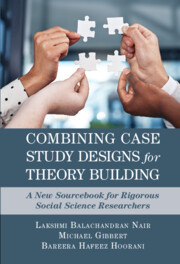 Combining Case Study Designs for Theory Building
Combining Case Study Designs for Theory Building Book contents
- Combining Case Study Designs for Theory Building
- Combining Case Study Designs for Theory Building
- Copyright page
- Contents
- Chapter 1 Introduction to Case Study Research
- Chapter 2 Building Blocks of Case Study Research
- Chapter 3 Of Talking Pigs and Black Swans
- Chapter 4 Do It Again
- Chapter 5 The Natural Experiment, a.k.a. the Single Embedded Design
- Chapter 6 Do It Again (and Again)
- Chapter 7 Sequencing Case Study Designs
- Chapter 8 More on Sequencing Case Study Designs
- Chapter 9 A Parting Note, on an Optimistic Note
- Index
- References
Chapter 5 - The Natural Experiment, a.k.a. the Single Embedded Design
Published online by Cambridge University Press: 02 February 2023
- Combining Case Study Designs for Theory Building
- Combining Case Study Designs for Theory Building
- Copyright page
- Contents
- Chapter 1 Introduction to Case Study Research
- Chapter 2 Building Blocks of Case Study Research
- Chapter 3 Of Talking Pigs and Black Swans
- Chapter 4 Do It Again
- Chapter 5 The Natural Experiment, a.k.a. the Single Embedded Design
- Chapter 6 Do It Again (and Again)
- Chapter 7 Sequencing Case Study Designs
- Chapter 8 More on Sequencing Case Study Designs
- Chapter 9 A Parting Note, on an Optimistic Note
- Index
- References
Summary
We discuss the single embedded case study design in this chapter. We deliberate how this design is different from multiple and single holistic designs in terms of the levels of analysis and the nature of replication. The selection rationale and sampling are discussed next. Afterwards, we move on to the longitudinal and/or cross-sectional single embedded designs. The strengths and the weaknesses of the design in terms of internal validity, external validity, and the number of variables are discussed subsequently. This chapter also discusses the (mis)conception regarding longitudinal designs and temporal embedded units.
Keywords
Information
- Type
- Chapter
- Information
- Combining Case Study Designs for Theory BuildingA New Sourcebook for Rigorous Social Science Researchers, pp. 78 - 103Publisher: Cambridge University PressPrint publication year: 2023